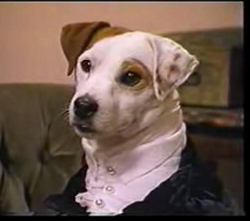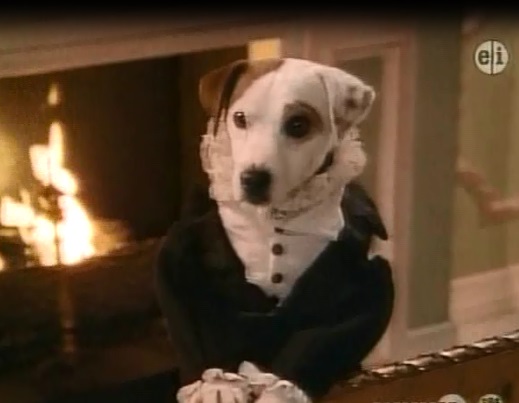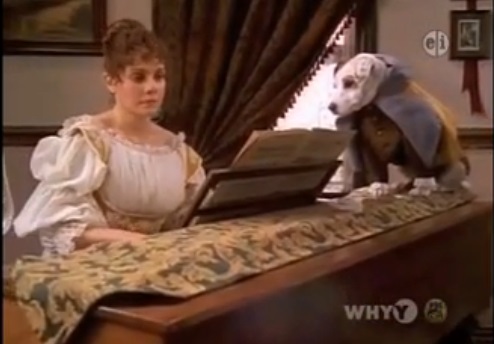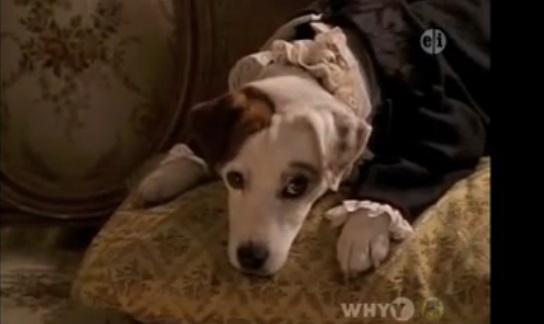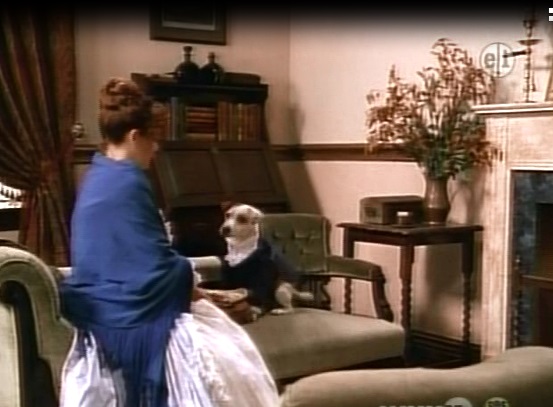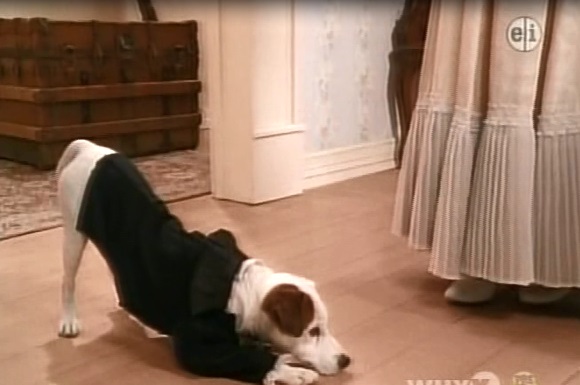|
“Furst Impressions,” an episode of the PBS children’s television series Wishbone (1995), is one of few adaptations of Pride and Prejudice that has not received much critical attention, although for many of today’s college students it has served as the introduction to the novel. In light of recent critical interest in cinematic portrayals of Mr. Darcy, it seems worthwhile to consider how an adaptation in which he is played by a Jack Russell terrier serves as a child’s first impression. While Wishbone the dog is adorable, he is not going to inspire romantic longing on the level of Laurence Olivier, Colin Firth, or Matthew Macfadyen. I will argue that the Wishbone episode is not only appropriate for children but lacks many of the Hollywood clichés and the “harlequinization” that frustrate scholars about Austen films aimed at adults. Like the 1940 screwball comedy that it most resembles, “Furst Impressions” presents Elizabeth Bennet and Darcy as moral and intellectual equals who are divided by exaggerated class differences that are nonetheless easily overcome. This lighthearted approach to the romance allows the episode to focus on lessons about overcoming social fears and dispelling rumors, elements from the novel downplayed in versions focusing on a highly romanticized love story.
Like all Wishbone episodes, “Furst Impressions” begins with a modern-day frame narrative in which Wishbone’s owner Joe and his friends have an experience similar to the plot of the featured literary work. In this case, they are nervous about an upcoming school dance because they don’t have dates or nice clothes, and bully Damont taunts them about sitting in the Losers Only section. Wishbone’s voiceover makes the connection to the novel: “Being nervous about parties happens to a lot of people. Read Jane Austen. Back in 1813, she wrote a juicy, meaty book about people and parties, Pride and Prejudice.” This framing introduces Austen as an author who provides instruction about situations involving “a lot of people,” not a romance between two people, and about how to overcome the pressures to have the right connections and the right clothes. This dilemma transcends gender, since Joe, David, and Samantha take on the roles of the unfashionable Bennet sisters facing the snobbery of Damont’s Caroline Bingley.
Already the episode resembles the 1940 film in its humorous tone—which inevitably follows from a dog who speaks in voiceover—and in its emphasis on the social context in which the plot unfolds. Critics have analyzed the wartime film as a lighthearted comedy that nonetheless performed important work of providing moral support in troubled times and evoking sympathy for the British. George Bluestone argues that both novel and film focus on “a scheme in which the claims of conflicting tendencies are ultimately adjusted through a process of moral education” (115), although George Lellis and H. Philip Bolton point out that the film failed to portray the subtleties of Lizzy’s inner life (46). The 1940 film was successful because it linked Austen to the genre of Hollywood comedy most popular at the time: “With its warring lovers, witty dialogue, class differences, opportunity for elaborate costumes, and comic minor characters, the novel lends itself to the broadly comic treatment of screwball comedies” (Parrill 49). While Wishbone’s first scene echoes the 1940 version with its focus on moral education, it provides a contrast to the “harlequinization” that Deborah Kaplan sees in later Austen films, in which “the focus is on a hero and heroine’s courtship at the expense of other characters and other experiences” (178). Although it would have been logical for a plot about a school dance to involve courtship, the frame narrative focuses on how to get along within a group. The kids will end up having fun at the dance because they do not succumb to the pressure to ask dates.
The episode then transitions into a mini-adaptation of Pride and Prejudice, and the parallels to the 1940 version continue when Lizzy is introduced in the context of her family, rather than walking alone outdoors like the more independent heroines of the 1995 miniseries and 2005 film. Jane and Lizzy are in the garden at Longbourn, where Lizzy gets dirt on her face and Wishbone’s voiceover tells us that “these two are comfortable anywhere,” setting them up as role models for the socially awkward preteens in the frame narrative. When Mrs. Bennet announces that Netherfield Hall has been rented and they must look nice for the ball, Lizzy says that “how we dress will not matter in the light of how we behave,” setting her apart from the more frivolous family members while reinforcing the theme: don’t worry about how others perceive you, but be yourself and have fun. These scenes reflect Austen’s portrayal of Lizzy as having “‘something more of quickness than her sisters’” (5) although they focus less on marriage than the novel’s opening chapters.
The Assembly Ball sequence follows the 1940 version in using slapstick comedy as the non-threatening space in which Lizzy and Darcy begin their battle of wits, while exaggerating their supposed class difference as the primary obstacle to their relationship. Caroline comes across as ridiculous rather than dangerously cruel: she makes such an elaborate bow that her feathered headdress almost knocks over Mrs. Bennet and makes Mary sneeze, tosses her punch cup over her shoulder to a servant, and pretends to be tripped by a country girl. When Mr. Bingley gestures towards his friend Darcy, we see an empty chair until Wishbone, wearing a black coat and ruffled collar, shyly rises up and puts his paws on the back of the chair.
This first impression is quite a comical change from Austen’s description: “Mr. Darcy soon drew the attention of the room by his fine, tall person, handsome features, noble mien” (10). Wishbone’s voiceover playfully introduces him: “Mr. Bingley’s rich and incredibly handsome friend, Mr. Darcy, is nervous at parties, so nervous he seems rude.” Lizzy rolls her eyes when Darcy runs away and flops onto a floor cushion, his own voiceover claiming that meeting new people gives him a headache. Although Darcy and Lizzy seem to meet on equal terms, with his extreme shyness paralleling her unfashionable dress, the class barrier comes up in exaggerated fashion when he calls her “Miss Beggar” instead of “Miss Bennet,” echoing the 1940 Darcy’s claim that “I am in no humor tonight to give consequence to the middle classes at play.”
As in other film and television versions, Lizzy reacts strongly when she overhears Darcy refusing to dance with her. In the novel, she remains seated and silent throughout the incident, although she later tells the story “with great spirit among her friends” (12). In the 1940 version, Darcy changes his mind and asks her to dance, but she responds sarcastically that “the honor of standing up with you, Mr. Darcy, is more than I can bear” and accepts Wickham instead. This film tradition continues as Lizzy giggles with Charlotte in front of Darcy in the 1995 miniseries and taunts Darcy by recommending dancing “even if one’s partner is barely tolerable” in the 2005 film. In Wishbone, Lizzy gets angry over Darcy’s words and walks away, proclaiming, “I certainly do not need to beg him to be my partner!” She refuses to be seen as a beggar or to be confined to her wallflower position.
Wishbone distinguishes itself from other period adaptations of Pride and Prejudice by returning to the frame narrative at regular intervals, thus avoiding the tendency of many costume dramas to linger on clothes and furnishings at the expense of plot. Andrew Higson describes the type of heritage film that invokes viewers’ nostalgia for the wealth of bygone eras: “The strength of the pastiche in effect imprisons the qualities of the past, holding them in place as something to be gazed at from a reverential distance, refusing the possibility of a dialogue or confrontation with the present” (65). In its own irreverent way, Wishbone does contain a dialogue with the present. The Assembly Ball scene ends with a match cut from the dancers’ shoes to an advertisement for overpriced sneakers that Joe begs his mother to buy for the dance, clearly linking Regency wealth to today’s empty consumerism and allowing Joe’s sensible mother to remind him that expensive clothes will not make people like him more.
We return to the mini-adaptation with another match cut from Wishbone’s face to Caroline’s distorted reflection as she examines herself in a silver coffee pot, further mocking her lust for wealth. Caroline taunts Darcy about his preference for Lizzy, which he dismisses with a reference to class: “I can’t marry a poor girl.” A similar exchange occurs at the Netherfield Ball, when Caroline stuffs cake into her mouth as she warns Lizzy not to believe Wickham because “the poor are great liars.” Lizzy wipes Caroline’s mouth and comments: “I know that money does not buy good character.” As in 1940, the class barrier is simply asserted, though there is little apparent difference in the houses or costumes of the Bennets and Bingleys. This kind of reference to “the poor” is not echoed in the frame narrative, in which all of the children belong to the middle class. Instead the focus is on the danger of rumors, as the kids start fighting when they hear false reports that David and Samantha have asked dates to the dance. Perhaps contemporary class conflict was too sensitive a subject even for a progressive public television show in which the kids are carefully multicultural, whereas the minor class difference between Elizabeth and Darcy provides a convenient device for keeping them apart.
While the 1940 version replaces Lizzy and Darcy’s first dance with the famous archery scene in which she teaches him not to underestimate women, Wishbone gives the dance a similar feminist quality. The dog spins in circles on the floor as Lizzy and the other humans tower over him, a comic visualization of the parallel scene in the novel, in which Darcy is dwarfed and discomforted by Lizzy’s punishing wit. Wishbone maintains the focus on Darcy’s need to learn how to act in social settings whereas Austen makes it clear that Lizzy’s infatuation with Wickham and willingness to believe his rumors represent an equally serious character flaw. Wishbone downplays these mistakes by portraying Wickham as a foppish caricature rather than a real threat, thus placing more emphasis on Darcy’s need for reform. The focus remains on the importance of social skills, in contrast to the romantic 2005 film in which the couple becomes so wrapped up in each other that everyone else disappears.
By the time he appears at Hunsford, this Darcy has overcome most of his pride and turned into the abject and adoring lover who sits on the piano and gazes at Lizzy while she plays. In contrast to the deliberate movements of Austen’s Darcy, who “stationed himself so as to command a full view of the fair performer’s countenance” (195), the dog appears below Lizzy and entirely at her mercy. Wishbone’s Darcy reminds viewers of the dogs that follow the hero around in the 1980 and 1995 miniseries, their soulful eyes expressing their owner’s more repressed desires. As the voiceover explains that Darcy fell in love despite his intentions, the dog’s face is superimposed on pages of sheet music while we hear romantic strings on the soundtrack. The camera is simply filming the dog’s normal facial expression, but Wishbone’s liquid brown eyes uncannily resemble those of Colin Firth when his face is superimposed on Lizzy’s window and mirror in the other 1995 version. Wishbone shares that version’s emphasis on Darcy’s point of view, since the dog narrates the story and plays one of the main characters, but it does not join in what Lisa Hopkins describes as “fetishizing and framing Darcy and offering him up to the female gaze” (112). Instead, this scene has the highly comic effect of making current adult viewers laugh at the memory of the romantic excesses of Firth-mania.
The first proposal scene portrays Darcy as well intentioned but nervous and awkward, in contrast to Austen’s description of his conceited, angry, and hurtful words. The scene begins with the dog pacing the floor: “I’ll do it! No, I can’t!” As in the 1940 film, Lizzy walks into the room where he is waiting. This adaptation is a major departure from the novel, in which Lizzy is trapped in the room as Darcy enters and leaves, the confined space “heightening the drama because there is no means of emotional relief” (L. Kaplan). Here Lizzy has the upper hand as she coolly says, “You asked to speak with me?”
The dog jumps up on the couch but is still several feet below her when he declares, “You must allow me to tell you how ardently I admire and love you.” String music plays, and Lizzy looks ecstatic until he continues, “I know it’s ridiculous for me, a Darcy, to love you, who have no fortune at all.” Lizzy responds with an angry speech based on the novel, with Darcy saying all the wrong things:
LIZZY: In this situation, I believe it is customary in polite society to express my obligation to you for the honor of your proposal.
DARCY: Kind of makes you feel like Cinderella, doesn’t it?
Lizzy marches toward the door while the dog runs after her, calling out, “Wait, no! It just came out wrong!” She berates him for his treatment of Jane and Wickham and then shuts the door in his face. This behavior is quite a departure from Austen’s overwhelmed heroine, who “from actual weakness sat down and cried for half an hour” after Darcy leaves the room (216), or from the free-spirited heroine of 2005, who meets Darcy outside during a rainstorm and nearly kisses him. The Lizzy in Wishbone is empowered but still has much to learn. The scene ends with a split screen showing both Lizzy and Darcy saying, “I am most seriously confused.” Her feelings are a mirror image of his, with the split screen emphasizing their equality.
Because neither Lizzy nor Darcy needs the kind of extensive moral reform that we find in the novel, the episode concludes very rapidly. Although the first proposal scene appears halfway through the novel, there are only about five more minutes of “Furst Impressions.” We return to the frame narrative for a quick resolution, in which Joe brings his friends together at the dance and makes them all apologize. Wishbone narrates that “Mr. Darcy apologized too” as we cut to the dog bowing down before Lizzy’s feet.
The voiceover continues: “To make his wrongs right, he brought Bingley back to see Jane. Elizabeth found out that George Wickham was a big liar.” As in the 1940 version, the second proposal takes place in the garden, which earlier established Lizzy as “down to earth” and comfortable with anyone. The dog digs a hole for Lizzy and asks if they could learn more about each other in the future. She extends her hand and Darcy—after some hesitation—places his paw in it. The egalitarian nature of this proposal is highlighted when we see Bingley kneeling before Jane and offering her a ring in a more conventional manner. The two couples share their news and the scene ends with Darcy’s wistful “Everyone’s getting kisses. Except me.” For those critics who have been frustrated with the kissing in recent films, this change may be welcome.
Wishbone sums up the episode’s social lessons in the final scene, over shots of the kids having fun together at the dance: “What have we learned? Never judge a book by its cover. Don’t worry about how other people see you. Get the facts straight from the horse’s mouth.” Although “Furst Impressions” does not attempt a traditional fidelity to Austen, these lessons are present in the novel, with its concern about the destructive effects of believing rumors from the likes of Wickham and of allowing pride to prevent one from telling the truth. While Austen does not conclude with such trite moralizing, she does emphasize the community surrounding the newlyweds. Her last sentence focuses on the Gardiners: “Darcy, as well as Elizabeth, really loved them; and they were both ever sensible of the warmest gratitude towards the persons who, by bringing her into Derbyshire, had been the means of uniting them” (431). The 1995 miniseries and the 2005 film, each concluding with a kiss between Darcy and Elizabeth, suggest that the central conflicts are resolved by the couple, not by the community. The Wishbone version appeals to children but also provides a refreshing alternative for all viewers who appreciate the friendships, social rituals, and good manners that sustain Austen’s happy couples.
Works Cited
Austen, Jane. Pride and Prejudice. Ed. Pat Rogers. Cambridge: Cambridge UP, 2006. Bluestone, George. Novels into Film. Baltimore: Johns Hopkins UP, 1957. “Furst Impressions.” Wishbone. Writ. Vincent Brown. Dir. Ken Harrison. PBS, 1995. YouTube 21 May 2010. Web. 12 Aug. 2013. Higson, Andrew. English Heritage, English Cinema: Costume Drama since 1980. Oxford: Oxford UP, 2003. Hopkins, Lisa. “Mr. Darcy’s Body: Privileging the Female Gaze.” Jane Austen in Hollywood. Ed. Linda Troost and Sayre Greenfield. 2nd ed. Lexington: UP of Kentucky, 2001. 111-21. Kaplan, Deborah. “Mass Marketing Jane Austen: Men, Women, and Courtship in Two Film Adaptations.” Jane Austen in Hollywood. Ed. Linda Troost and Sayre Greenfield. 2nd ed. Lexington: UP of Kentucky, 2001. 177-87. Kaplan, Laurie. “Inside Out/Outside In: Pride & Prejudice on Film 2005.” Persuasions On-Line 27.2 (2007). Lellis, George, and H. Philip Bolton. “Pride but No Prejudice.” The English Novel and the Movies. Ed. Michael Klein and Gillian Parker. New York: Ungar, 1981. 44-51. Parrill, Sue. Jane Austen on Film and Television: A Critical Study of the Adaptations. Jefferson, NC: McFarland, 2002. Pride and Prejudice. Dir. Cyril Coke. Writ. Fay Weldon. Perf. Elizabeth Garvie and David Rintoul. BBC, 1980. Pride & Prejudice. Dir. Joe Wright. Writ. Deborah Moggach. Perf. Keira Knightley and Matthew Macfadyen. Focus Features, 2005. Pride and Prejudice. Dir. Robert Z. Leonard. Writ. Aldous Huxley and Jane Murfin. Perf. Greer Garson and Laurence Olivier. MGM, 1940. Pride and Prejudice. Dir. Simon Langton. Writ. Andrew Davies. Perf. Jennifer Ehle and Colin Firth. BBC and A&E, 1995.
|


